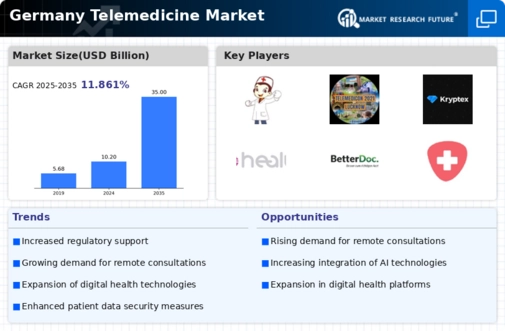Supportive Policy Framework
A supportive policy framework is crucial for the growth of the telemedicine market in Germany. The government has implemented various initiatives aimed at promoting telehealth services, including reimbursement policies that facilitate the integration of telemedicine into standard healthcare practices. Recent legislative changes have expanded the scope of services eligible for reimbursement, which is anticipated to increase telehealth utilization by approximately 25% over the next few years. Additionally, the establishment of clear guidelines for data privacy and security fosters trust among patients and providers, encouraging wider adoption of telemedicine solutions. This regulatory environment not only supports existing telehealth providers but also attracts new entrants into the market, thereby enhancing competition and innovation within the telemedicine market.
Rising Demand for Remote Healthcare
The telemedicine market in Germany experiences a notable increase in demand for remote healthcare services. This trend is driven by a growing population that seeks convenient access to medical consultations without the need for physical visits. According to recent data, approximately 30% of patients in Germany express a preference for telehealth options, indicating a shift in consumer behavior. The convenience of remote consultations, particularly for chronic disease management, is likely to enhance patient satisfaction and adherence to treatment plans. Furthermore, the aging population in Germany, which is projected to reach 23% by 2030, necessitates innovative healthcare solutions. This demographic shift suggests that the telemedicine market will continue to expand as healthcare providers adapt to meet the needs of an increasingly tech-savvy and health-conscious population.
Integration of Advanced Technologies
The integration of advanced technologies plays a pivotal role in shaping the telemedicine market in Germany. Innovations such as artificial intelligence (AI), machine learning, and data analytics are enhancing the efficiency and effectiveness of telehealth services. For instance, AI-driven diagnostic tools can assist healthcare professionals in making informed decisions, potentially reducing diagnostic errors by up to 20%. Moreover, the use of wearable devices and mobile health applications is on the rise, with a reported 40% of Germans utilizing such technologies for health monitoring. This technological evolution not only improves patient engagement but also streamlines healthcare delivery, making it more accessible. As these technologies continue to evolve, they are expected to drive further growth in the telemedicine market, enabling healthcare providers to offer personalized and timely care.
Increased Focus on Mental Health Services
The telemedicine market in Germany is witnessing an increased focus on mental health services, reflecting a broader societal recognition of mental health issues. The demand for mental health consultations via telemedicine has surged, with studies indicating that around 35% of individuals prefer online therapy options. This shift is likely influenced by the stigma associated with seeking in-person mental health care, which telemedicine can help mitigate. Furthermore, the convenience of accessing mental health professionals remotely is particularly appealing to younger demographics, who are more inclined to utilize digital health solutions. As mental health continues to gain prominence in public health discussions, the telemedicine market is expected to expand its offerings in this area, potentially leading to improved mental health outcomes across the population.
Growing Investment in Digital Health Solutions
Investment in digital health solutions is a driving force behind the expansion of the telemedicine market in Germany. Venture capital funding for health tech startups has increased significantly, with estimates suggesting a rise of over 50% in investment over the past year. This influx of capital is facilitating the development of innovative telehealth platforms and services that cater to diverse patient needs. Additionally, established healthcare providers are increasingly partnering with technology firms to enhance their telemedicine offerings, creating a more integrated healthcare ecosystem. The collaboration between traditional healthcare systems and digital innovators is likely to foster a competitive landscape, ultimately benefiting patients through improved access and quality of care. As investment continues to flow into the sector, the telemedicine market is poised for sustained growth.






















Leave a Comment